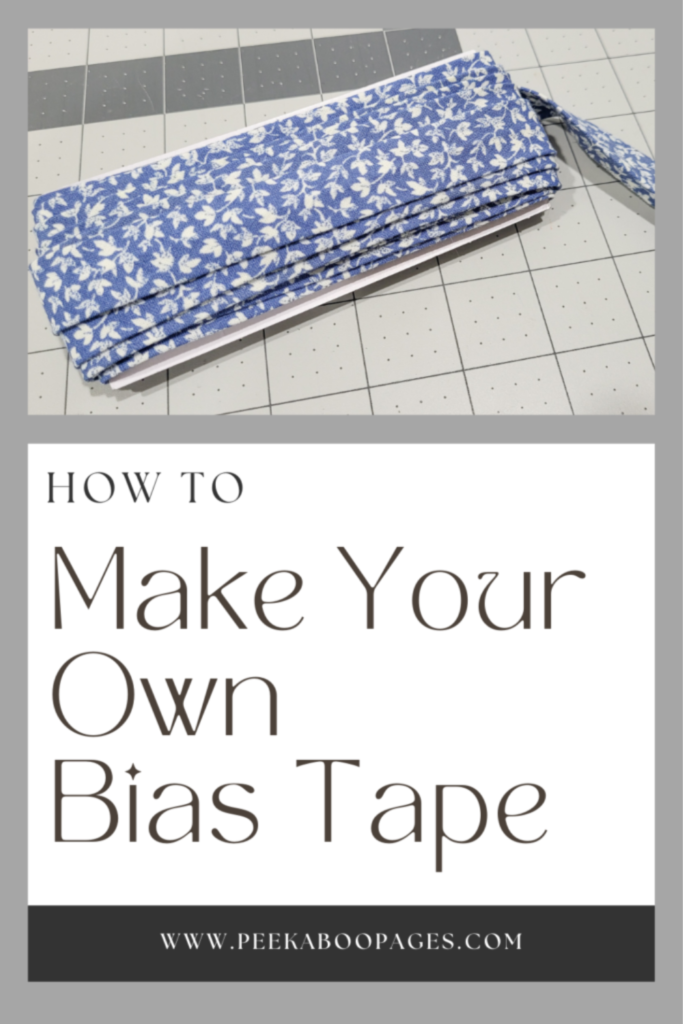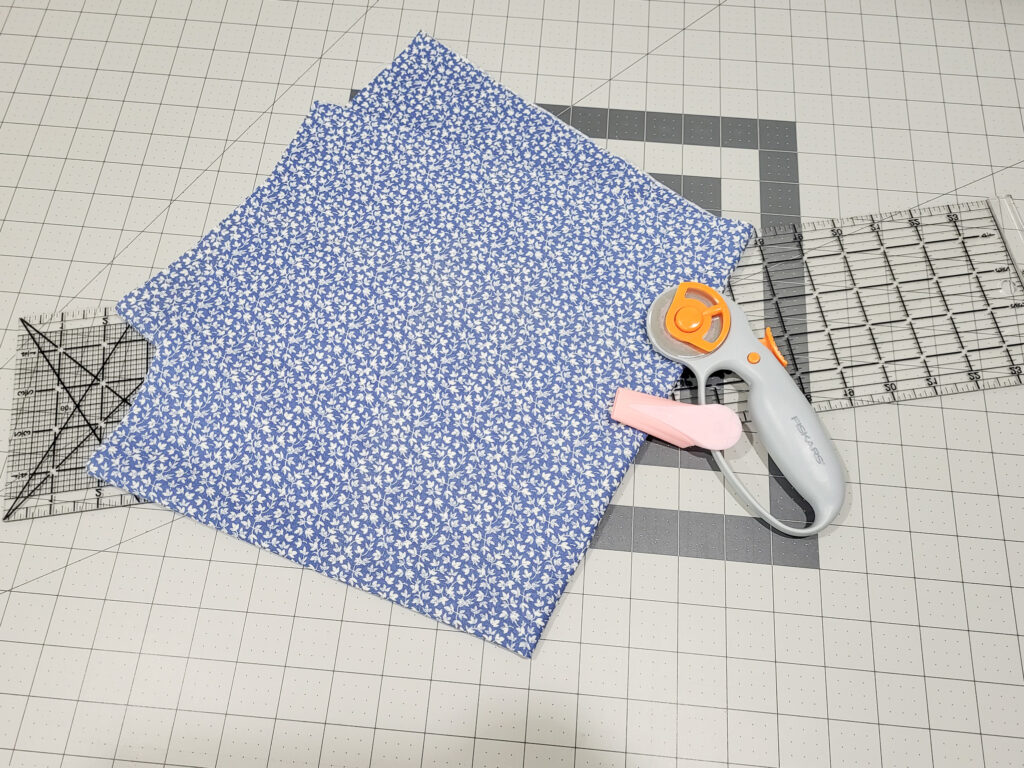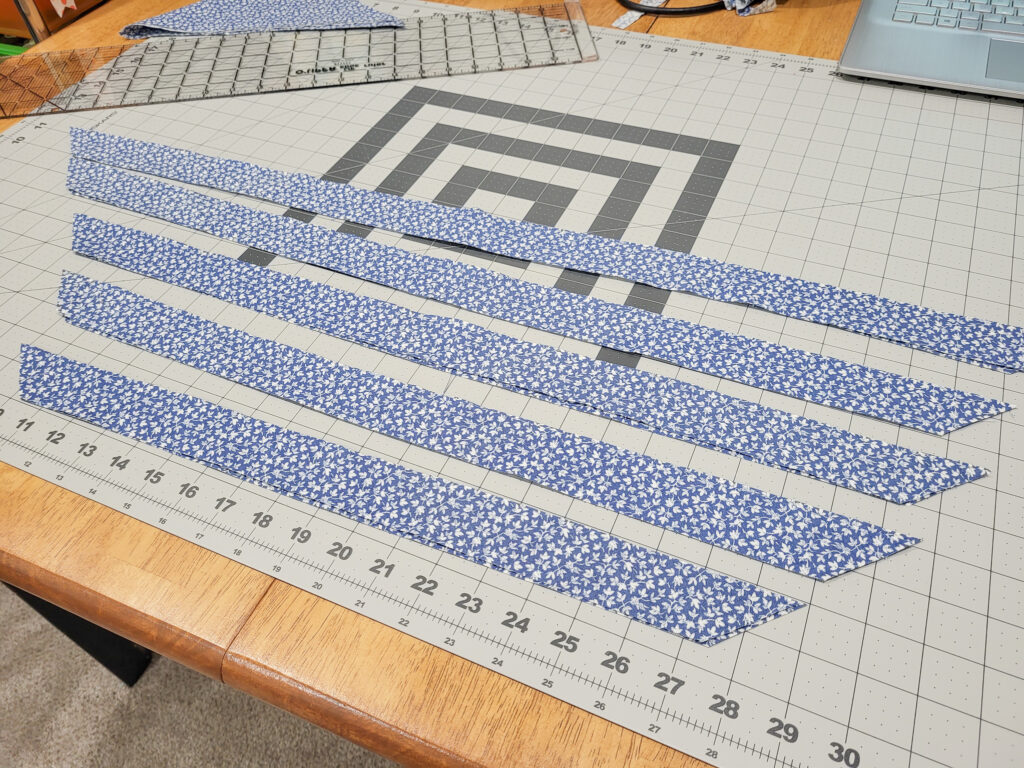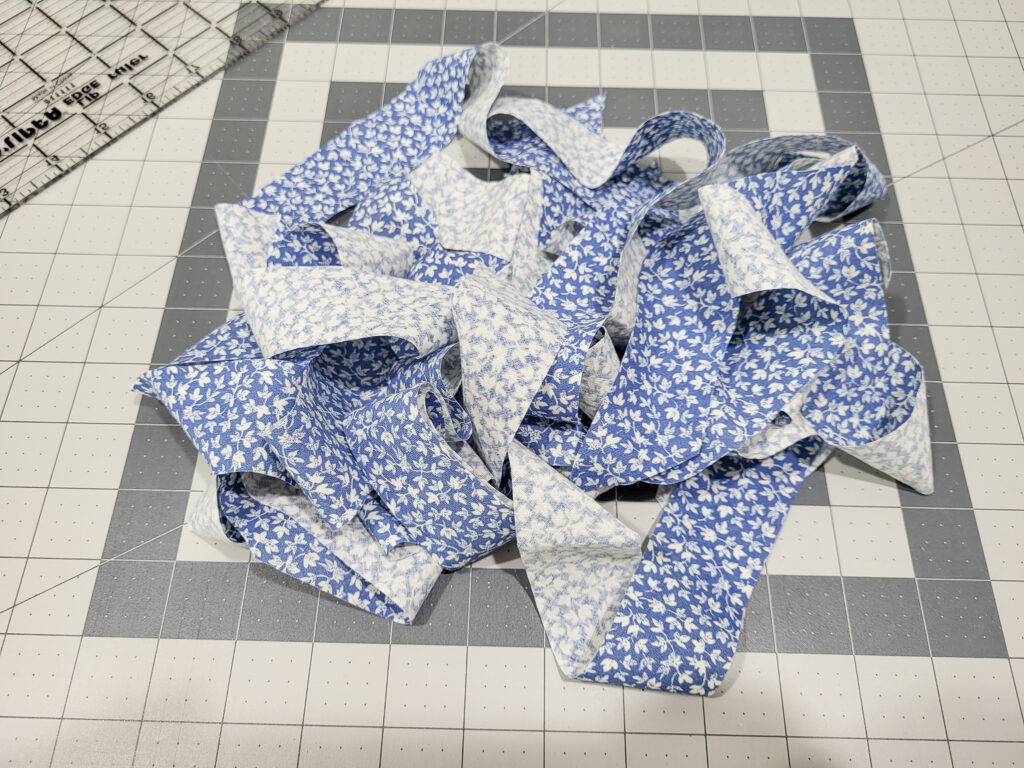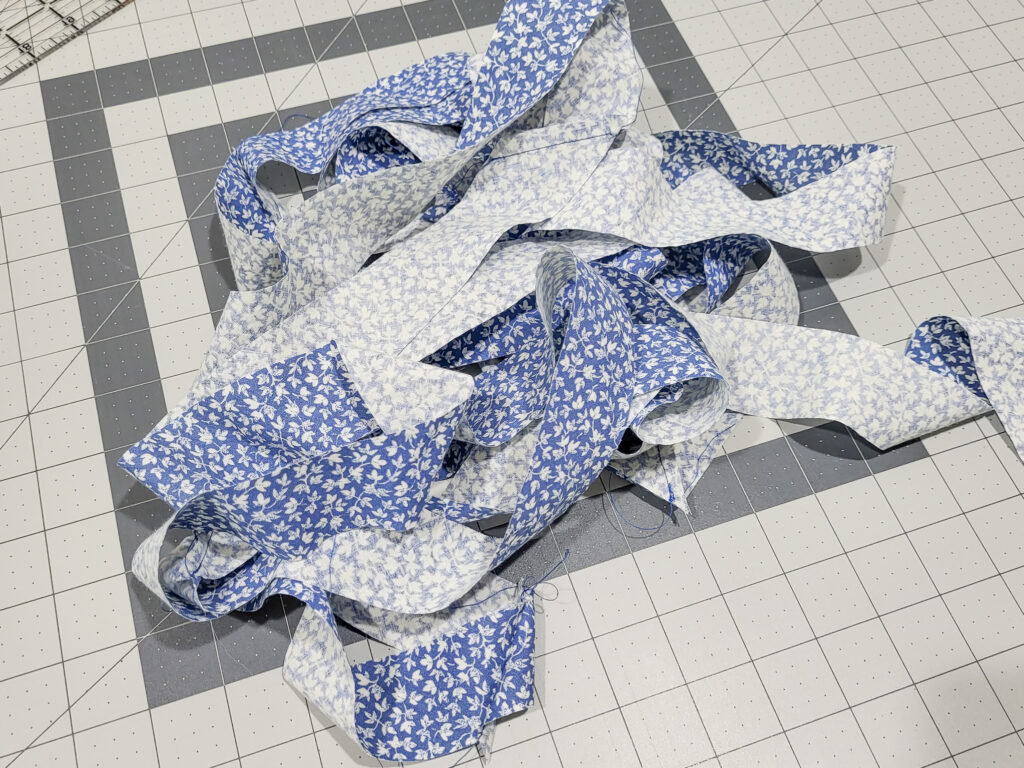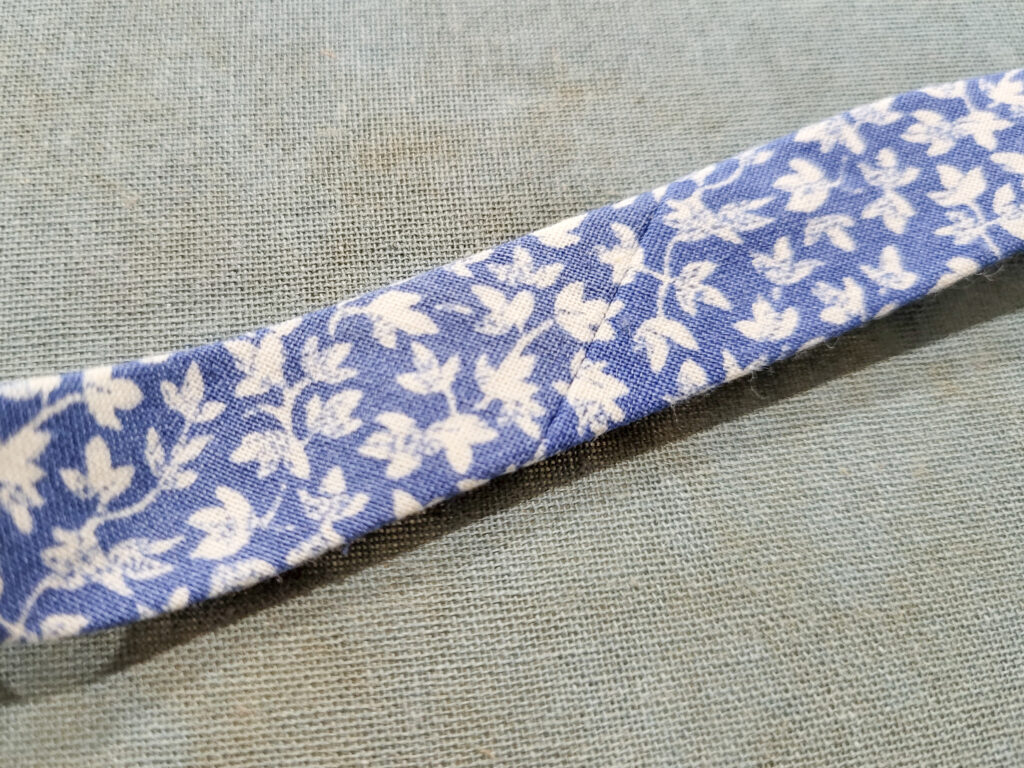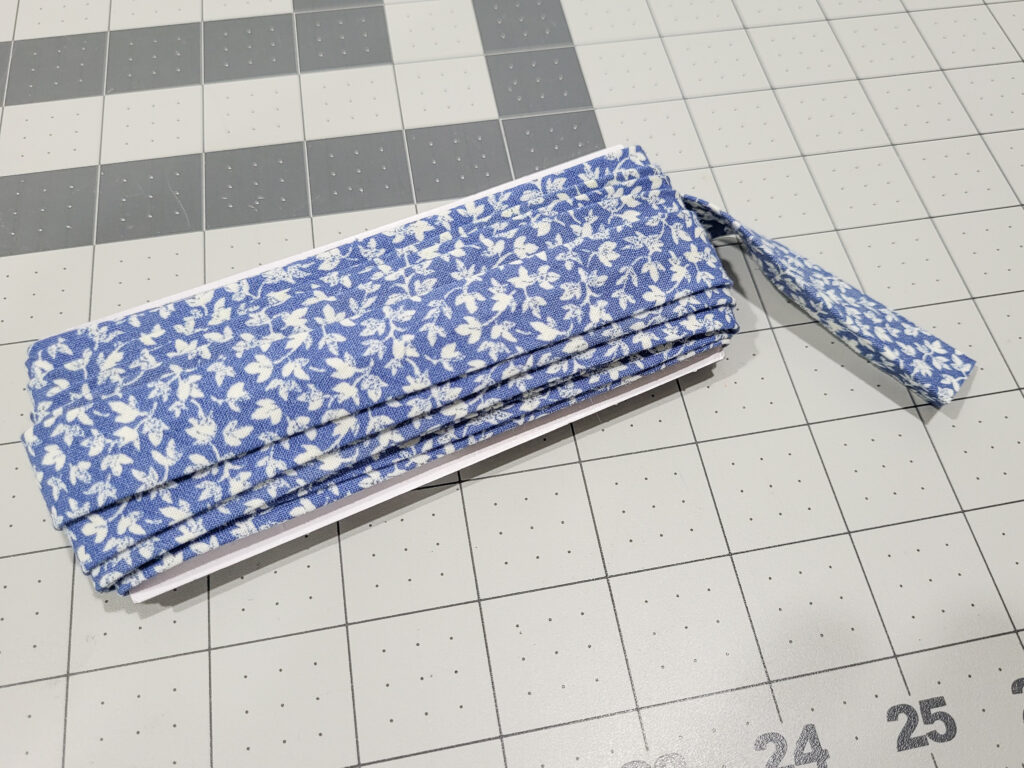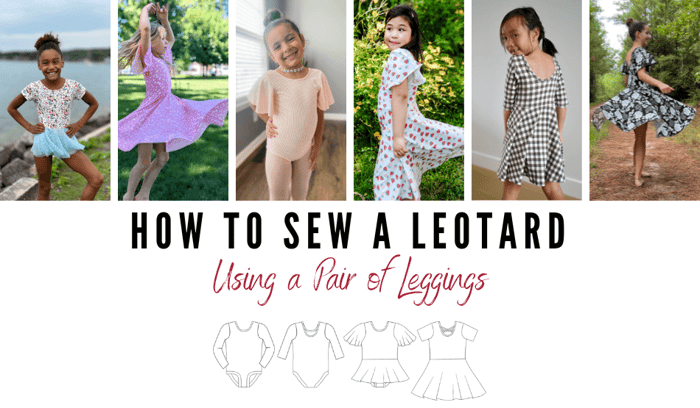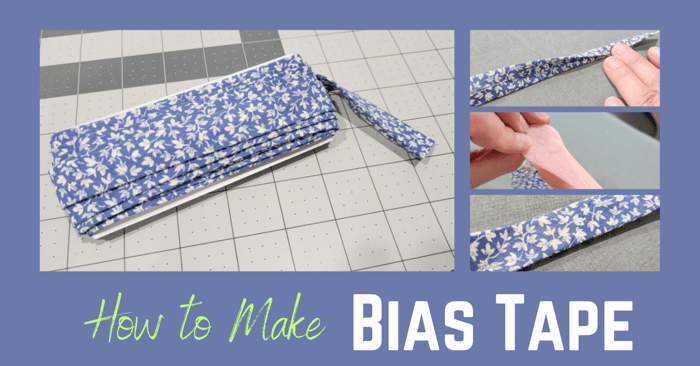
How to Make Bias Tape for Sewing Projects
Learning how to make bias tape is a simple and easy process that can help you create customized tape for your sewing projects. You no longer have to settle for the limited selection of pre-made bias tape available in the market, which often lacks creativity and texture. Making it at home allows you to choose your preferred color, size, and fabric, giving your projects a unique touch. To make your own, all you need is some fabric, a rotary cutter or scissors, and a bias tape maker tool. There are various methods to make bias tape, such as using a bias tape cutting machine or creating it by hand. Today, we'll go through te step-by-step process of making it by hand.
What is bias tape and why is it used in sewing?
Bias tape is a strip of fabric that is cut on the bias, or at a 45-degree angle to the straight grain of the fabric. It is used in sewing to finish edges, bind seams, add decorative touches, and create durable and flexible trims.
Why Would I Want to Make My Own Bias Tape?
Making your own bias tape can be a rewarding and practical choice for a variety of reasons. First, you have complete control over the fabric selection, allowing you to match it perfectly with your project. This level of customization can add a unique and personal touch to your creations. Additionally, it is often more cost-effective than store-bought options, especially if you have scrap fabric on hand. It also allows you to create bias tape in any width or length that you need, ensuring that it fits your project perfectly. So why settle for store-bought when you can make something truly one-of-a-kind?
With those basic questions out of the way, let's get into how to make it.
Learning How to Make Bias Tape from Fabric
DIY Bias Tape Supplies
- Fabric – I love a lightweight quilting cotton for bias tape. I prefer to use solids and dainty designs that hide seams well, but I have also seen beautiful tapes made in bold stripes and prints, too! The amount of fabric depends on how much bias tape you want to make. Today, a fat quarter should do.
- Cutting mat
- Rotary cutter
- Quilting ruler
- Bias tape maker in the correct size (I used a 3/4″ bias tape maker for this tutorial)
- Iron and ironing board
Cutting the Fabric
The first step of how to make bias tape is to cut a square of fabric along the grainline. Make sure to press your fabric really well to get rid of any wrinkles, and then use your cutting mat, quilting ruler, and rotary cutter to get nice straight lines for a fabric strip. Here’s a blog post on using a rotary cutter and mat to cut straight lines.
I cut my square 23″ x 23″, but you can do any size you like. The larger the square, the more you’ll be able to make. Make sure to have nice clean edges on the side of the fabric - you can get rid of any raw edge or selvage.
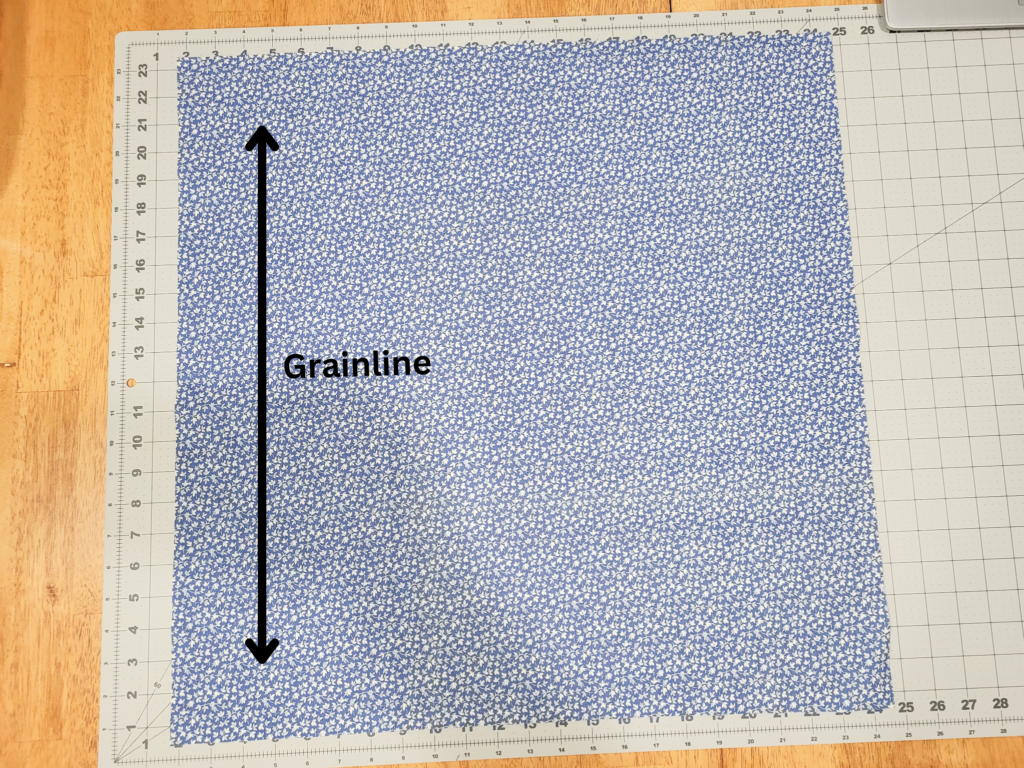
Next, you’ll need to fold your fabric along the diagonal. Take your bottom right corner and bring it towards the top left corner to make a triangle.
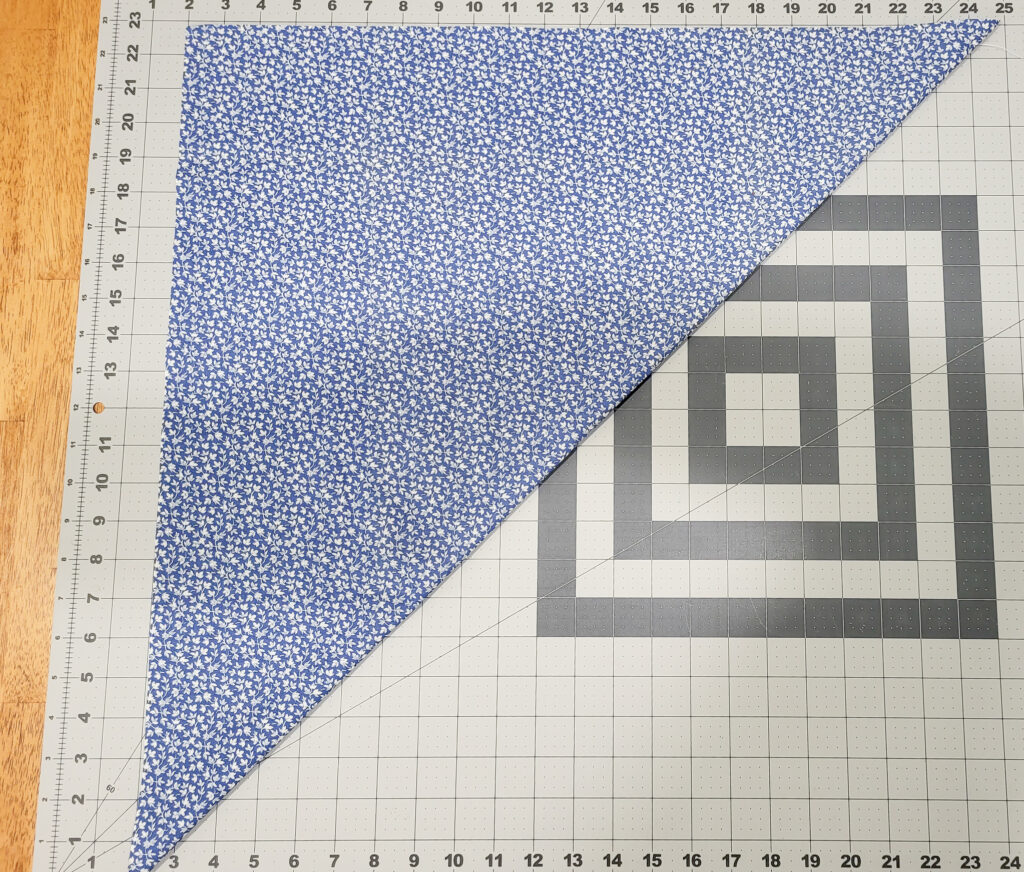
If you have a small enough piece of fabric and a large enough quilting ruler, you can go ahead and start cutting your first line along the diagonal edge of the fabric. My ruler is not big enough, so I’m going to do one more fold. Take your bottom left point and fold it up to the top right point, and you’ll end up with a smaller triangle. I know it doesn’t show it in my pictures, but make sure your top edges are aligned.
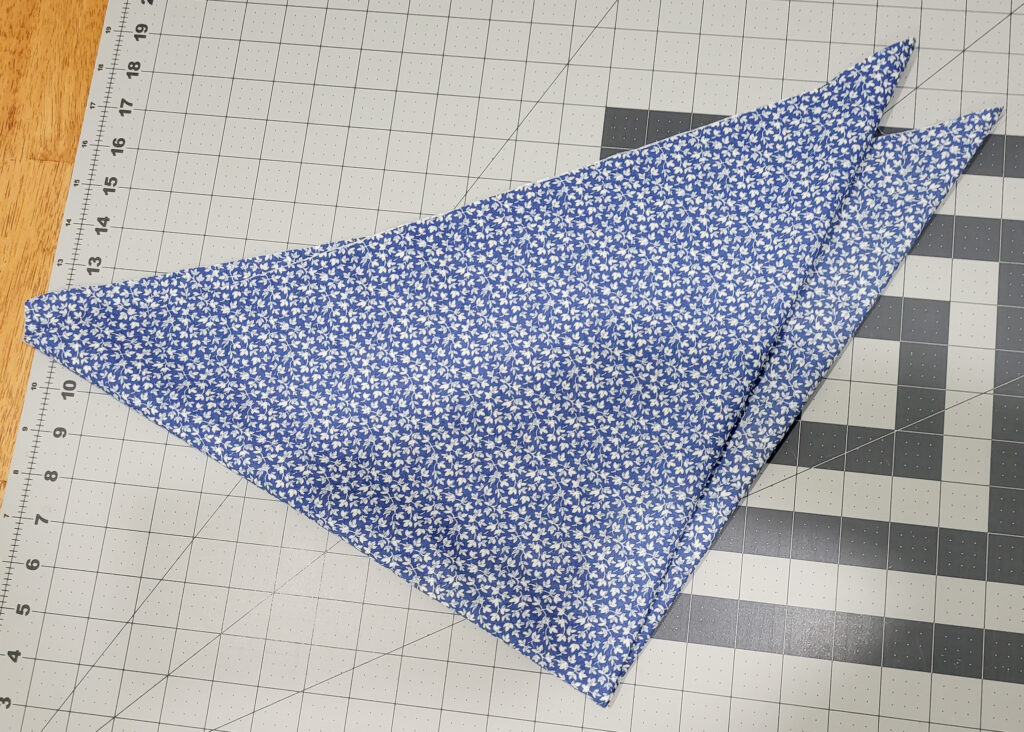
You’re going to want to make sure you pay attention to your edges to get the longest strips of fabric cut that you can from your piece. You’re going to cut parallel to the double-fold end.
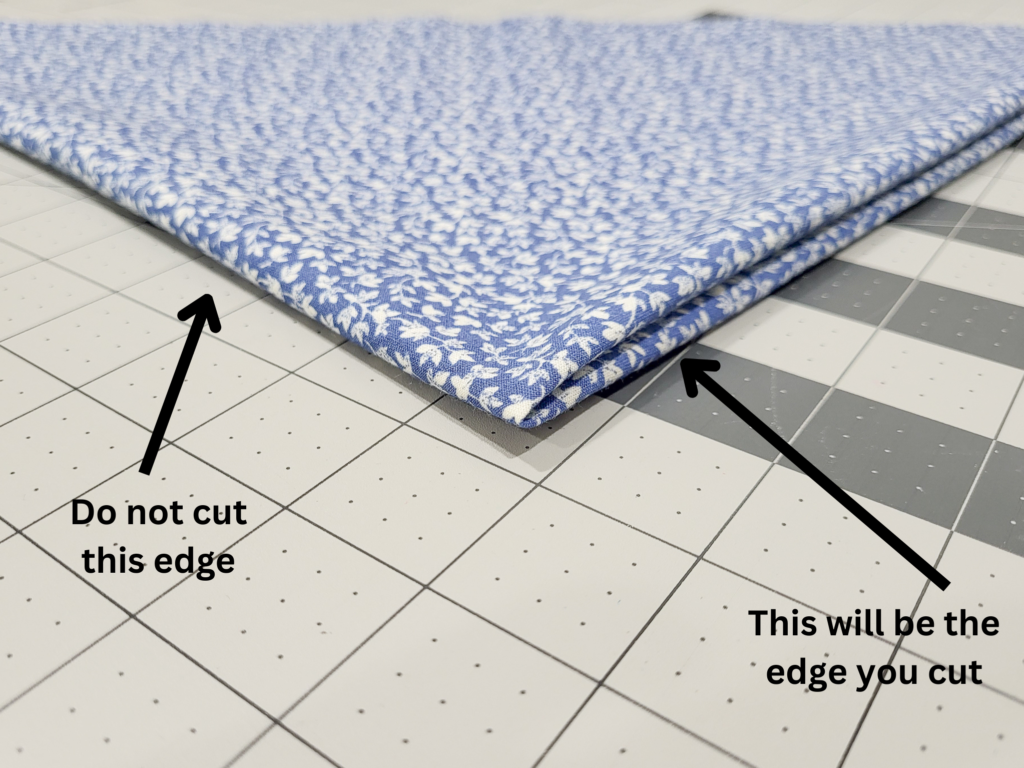
First, trim off a little bit of that double-fold edge to start your strips. I usually cut off about 1/4″.
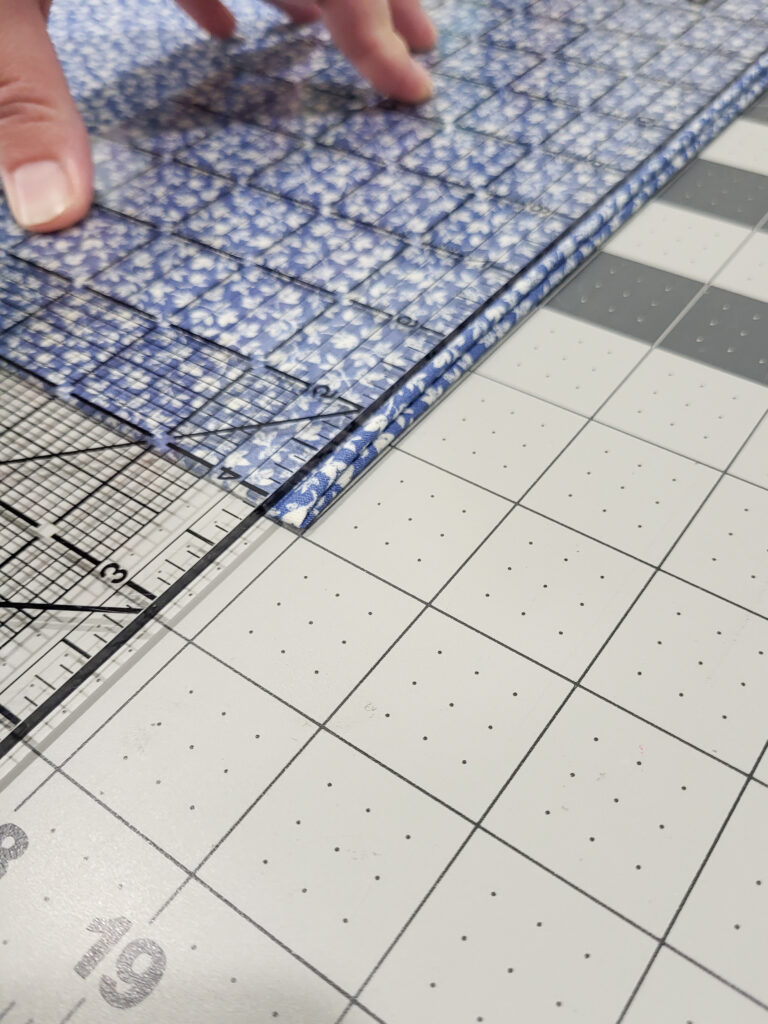
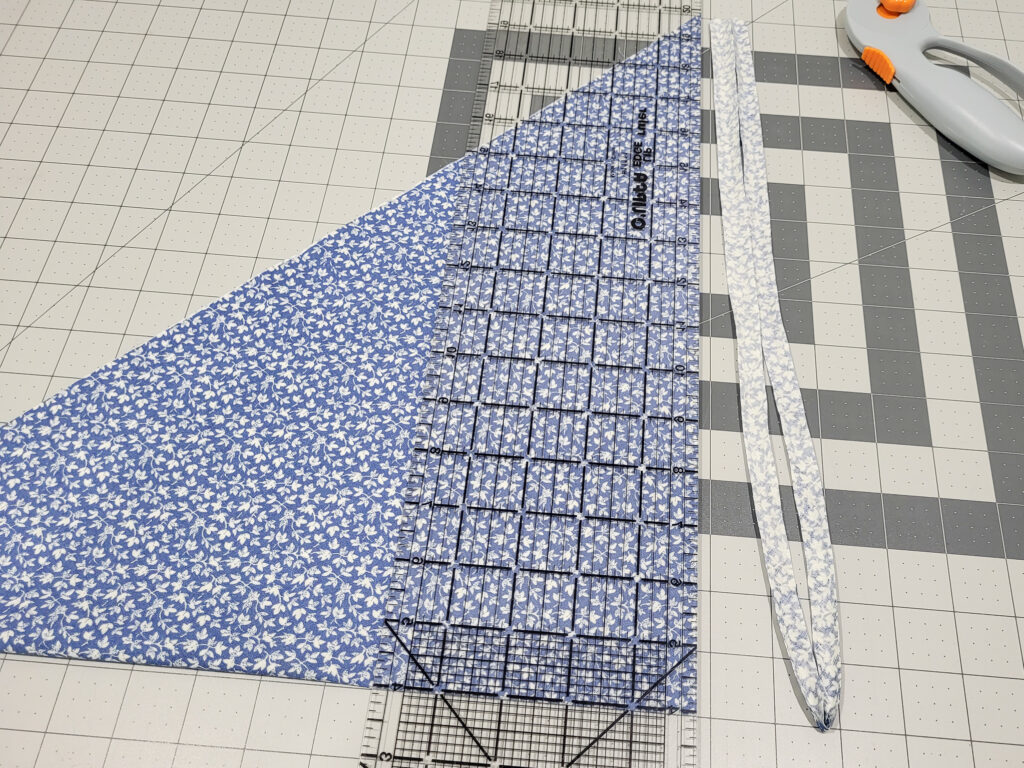
Now, you can start cutting your strips. The width of your long strip will depend on how wide you want your final size to be. For single-fold tape, your strips must be twice as wide as the final size. Since I will be making 3/4″ single-fold bias tape, I will need my strips to be 1 1/2 inches wide.
If you make 1/2″, your strips will need to be 1 inch wide, and so on and so forth. (For double-fold tape, your strips need to be four times wider than your final size. For example, for 1/2″ double-fold bias tape, you will need to start with strips that are 2″ wide.)
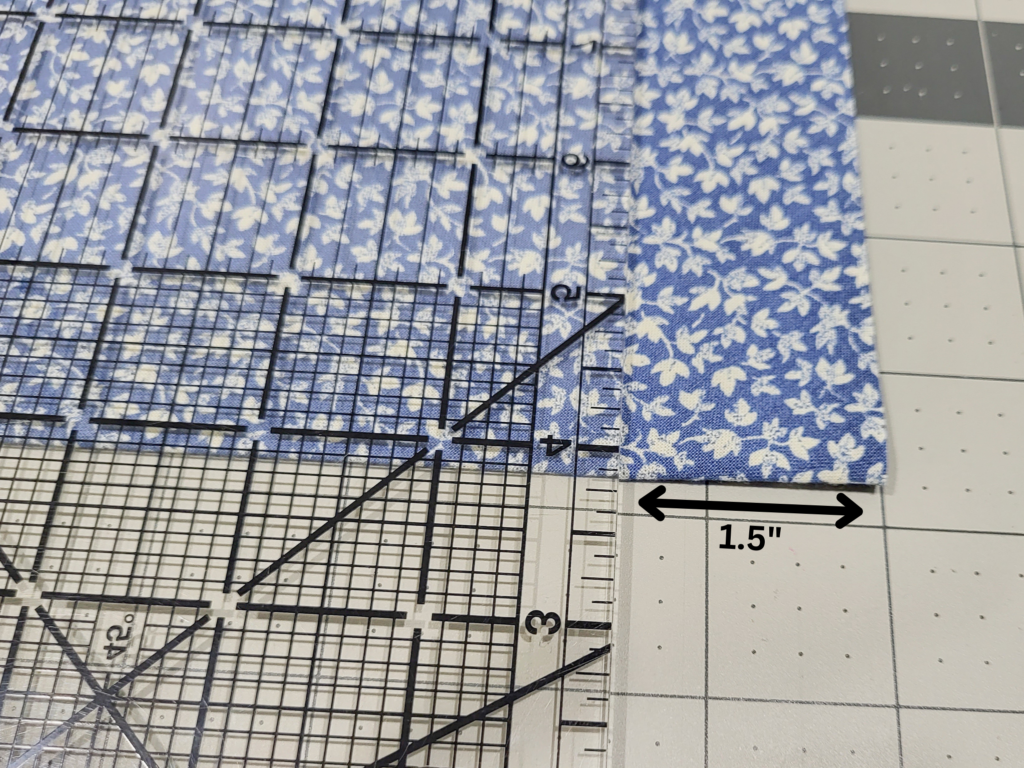
Start cutting your strips, making sure to get the correct measurement for the next line. How many strips you are able to cut depends on the size of your fabric square and how short you want your strips to get. You can keep cutting as long as you have the width, but I prefer to stop once my strips get less than 15″ long or so (because sewing together the tiny strips can get a little tedious).
Sewing the Strips
Now that you have all of our strips cut out, you’re ready to sew them together. It’s easy (for me at least) to get confused at what angles you should sew your strips together, so I often put my pieces next to each other at the angles at which they should connect to make sure I’m doing it right.
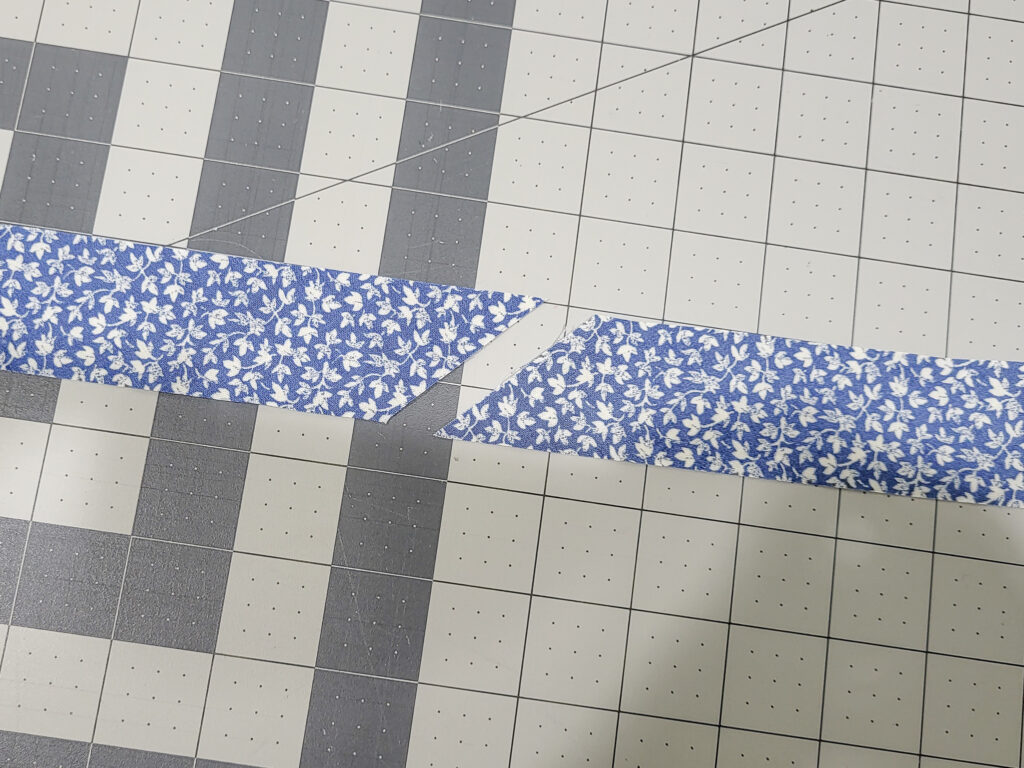
Align your diagonal line right sides together and offset the corners a little to allow for the seam allowance. I use a 1/4″ seam allowance as I sew my strips together. You can pin or clip your edges if you’d like, but I prefer to place my strips while I’m at my sewing machine and find I usually don’t need to pin or clip.
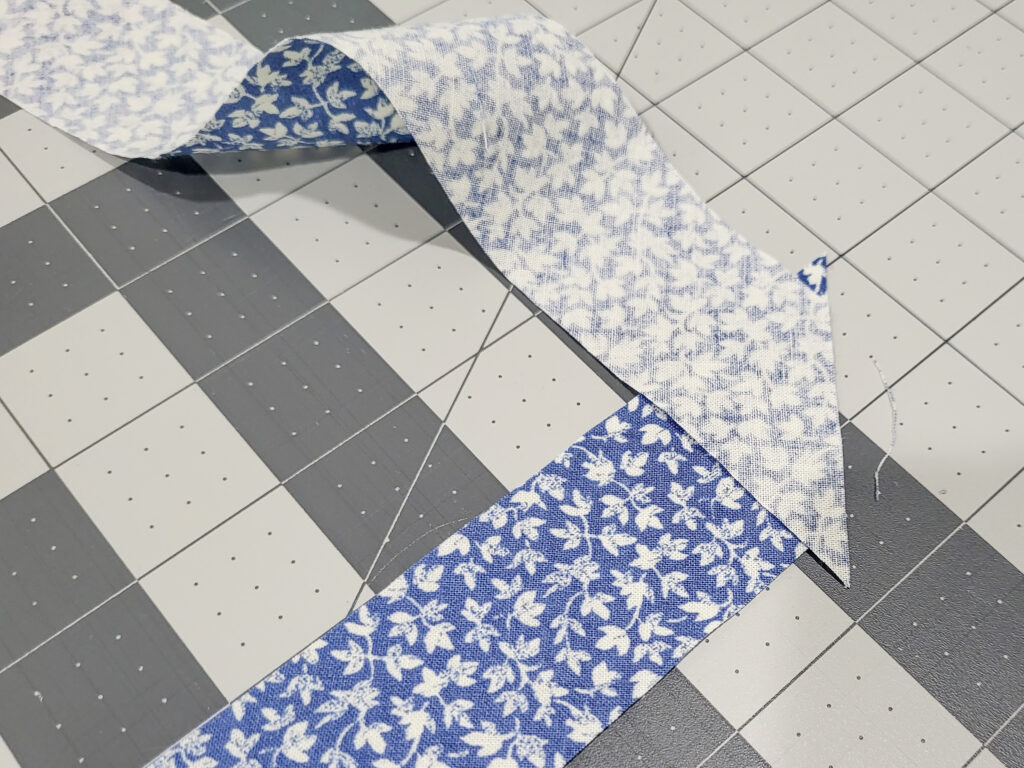
As you’re sewing, you’re going to want to try your best to start and end where your strips meet. I often adjust my seam allowance if I don’t have my pieces aligned perfectly for exactly 1/4″.
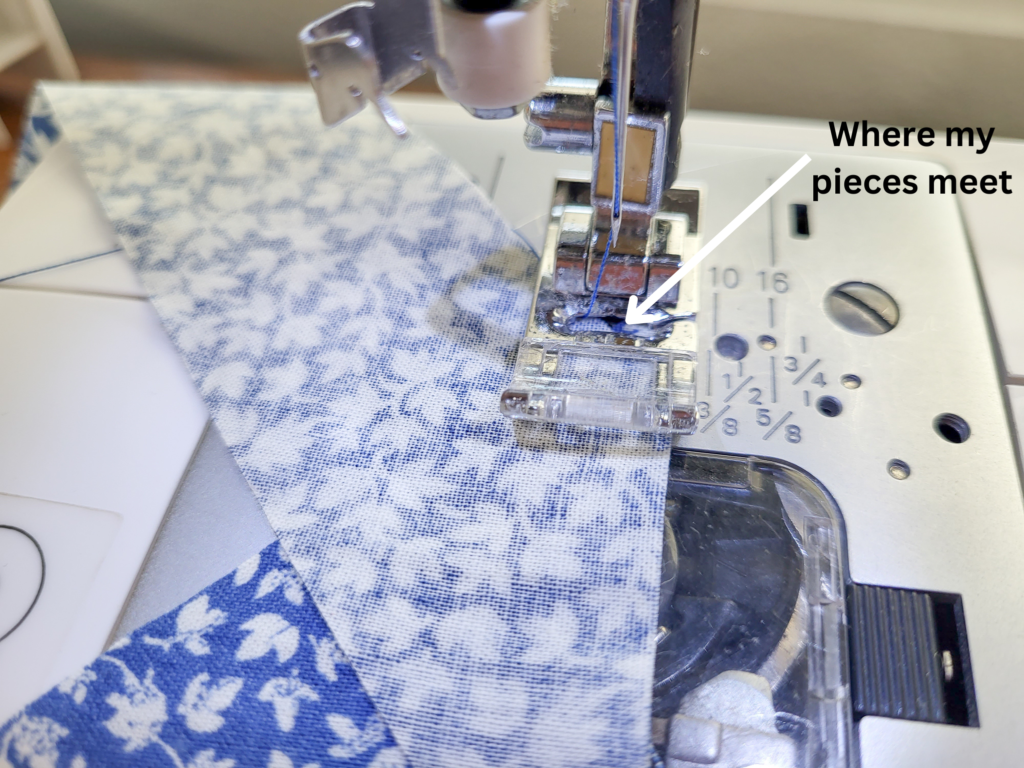
Now you can start to sew all your strips together. You’ll end up with seams like this.
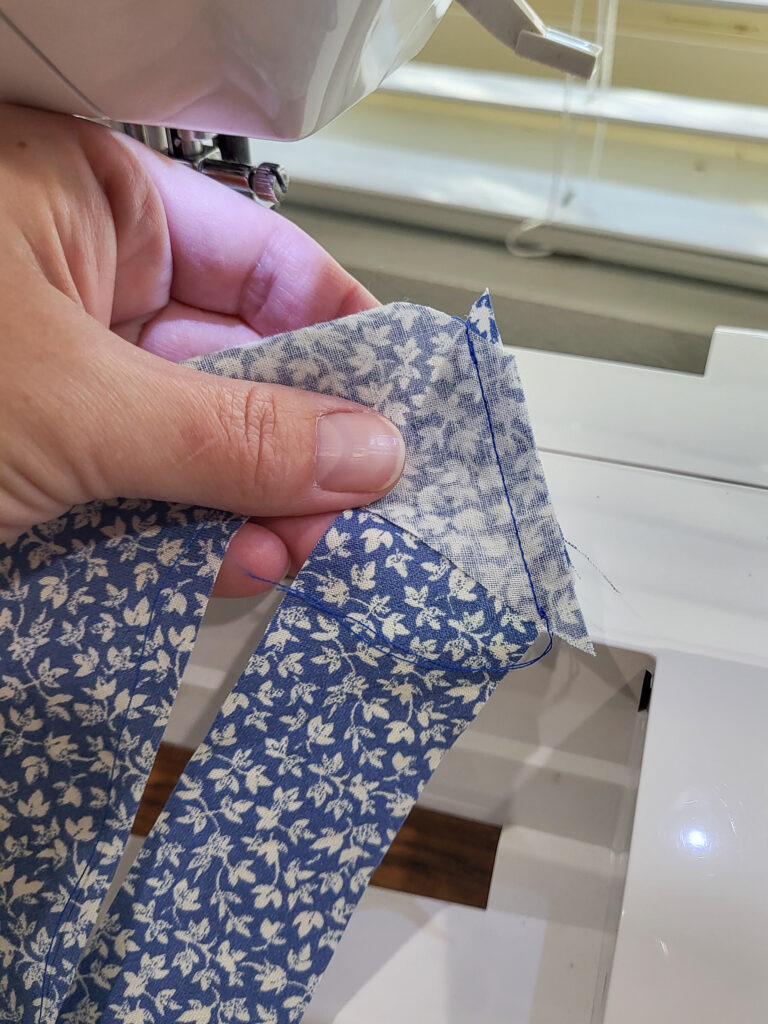
Keep going until you’ve sewn all your pieces together, and you’ll end up with a nice little pile like this.
Ironing
Now you get to fold and iron your tape, a process made much quicker with the use of a bias tape maker. Like I said above, the size of bias tape maker you need depends on the final size of tape you want. Just so you know, their sizes refer to single-fold tape. If you intend to make double-fold tape, you’ll end up with something half the size of your bias tape maker.
Before we pull out the bias tape maker, I like to iron my seams open to help the strip feed more easily through the maker in later steps.
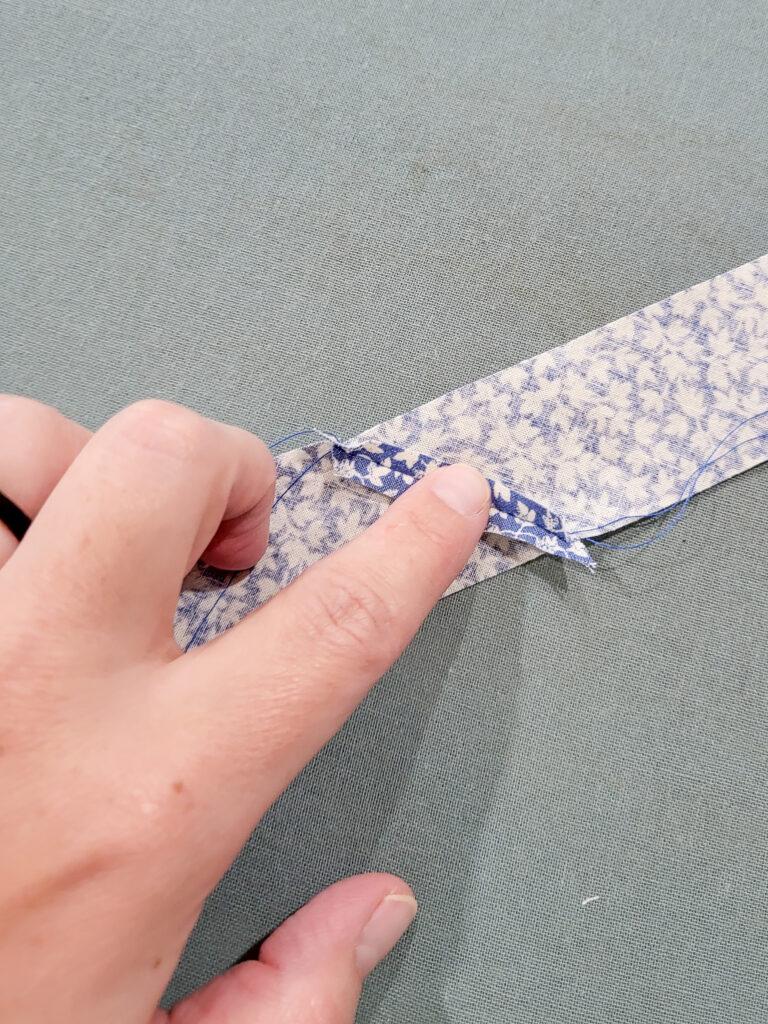
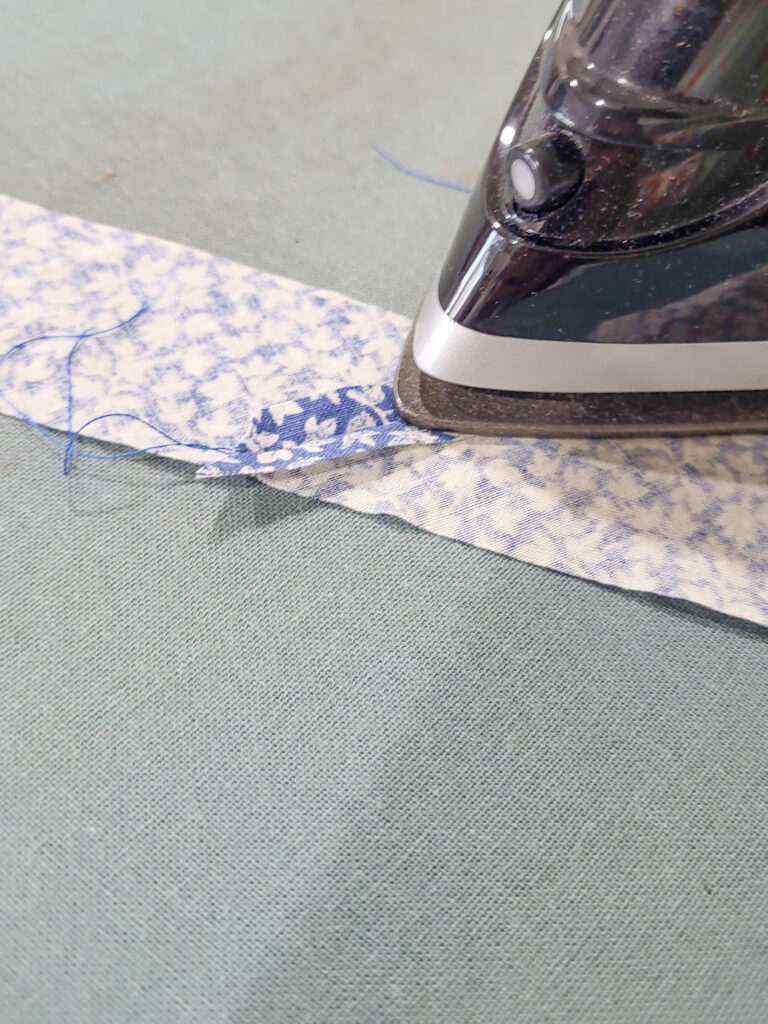
I also prefer to trim the threads and overhanging edges of my seams so they don’t bug me as I’m using the bias tape maker. It just makes things a little neater.
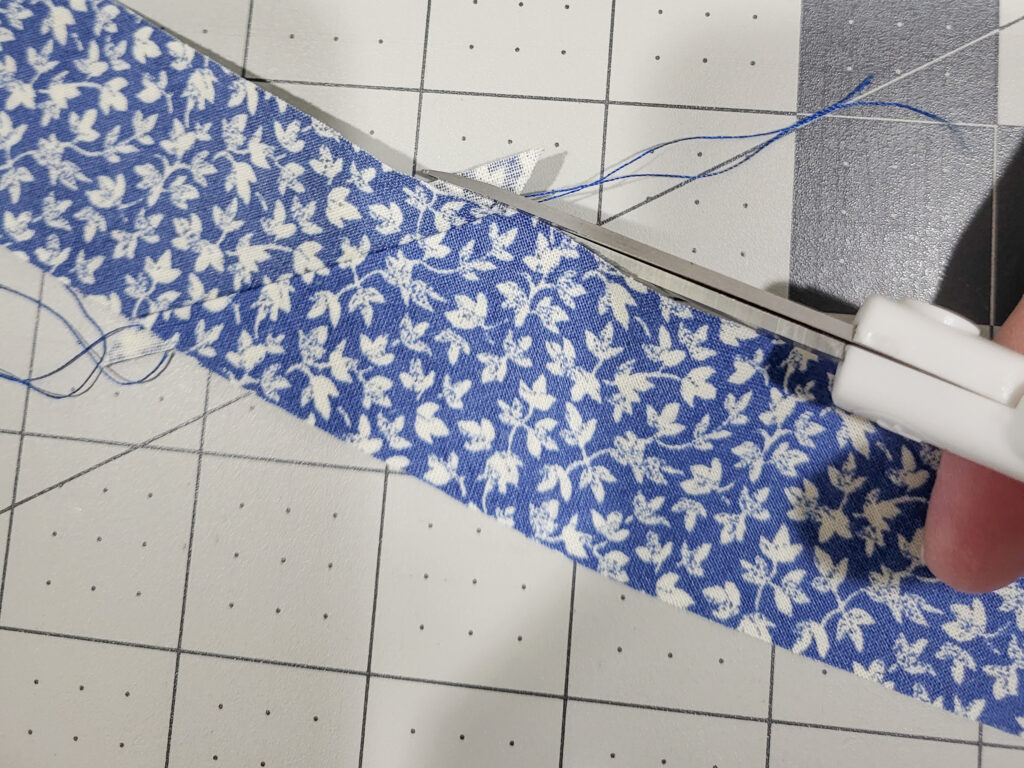

Now that we’ve prepped our giant strip, we can start feeding it through the bias tape maker. You will insert one edge of the strip through the wider end of the maker, along the bottom. Sometimes it take a little finagling and wiggling, but eventually you’ll get a corner through and be able to start pulling the rest of it. Continue to make adjustments to the fabric until all the wrinkles are out and it pulls through cleanly.
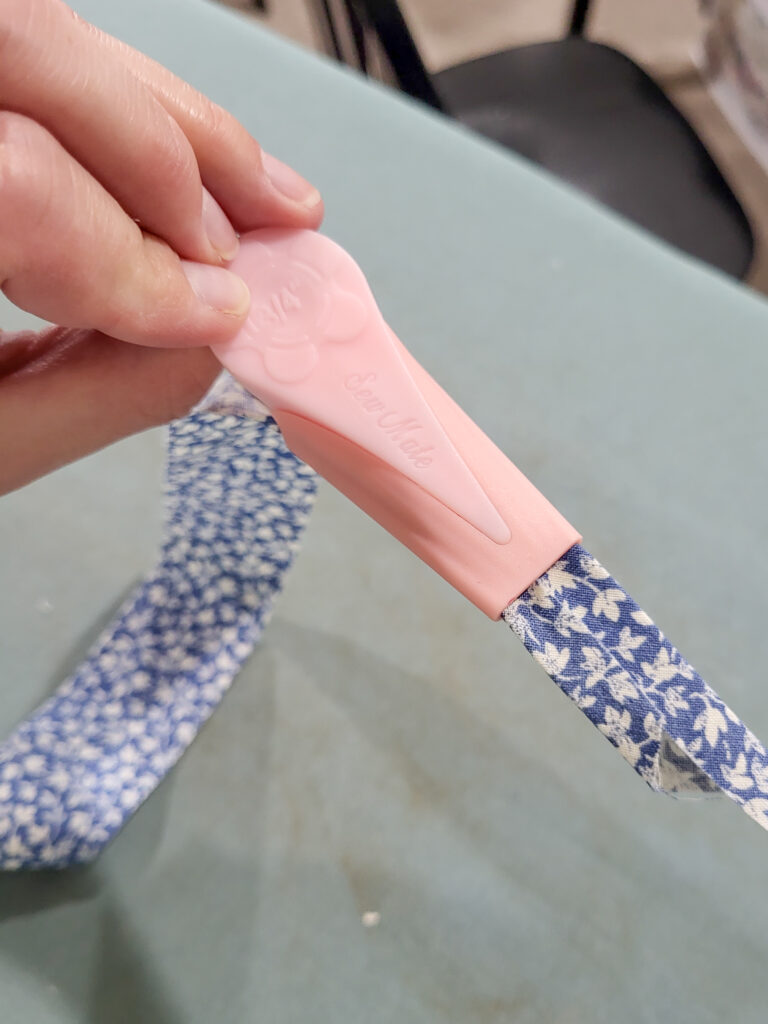
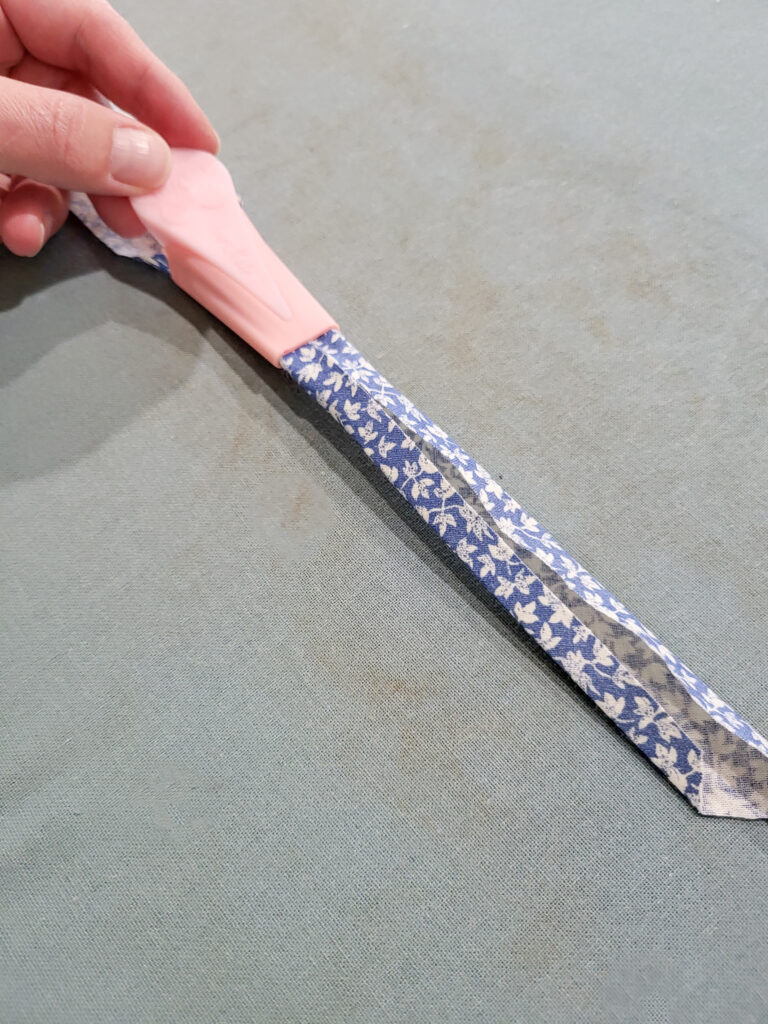
Once you have it looking how you like, you can start ironing as you pull. Since I am right handed, I hold the iron in my right hand and pull the bias tape maker with my left and move them along at the same rate. As I run out of ironing board, I make a pile of finished tape to the right of the iron and keep moving along. If you need help using a bias tape maker, check out this YouTube Tutorial.
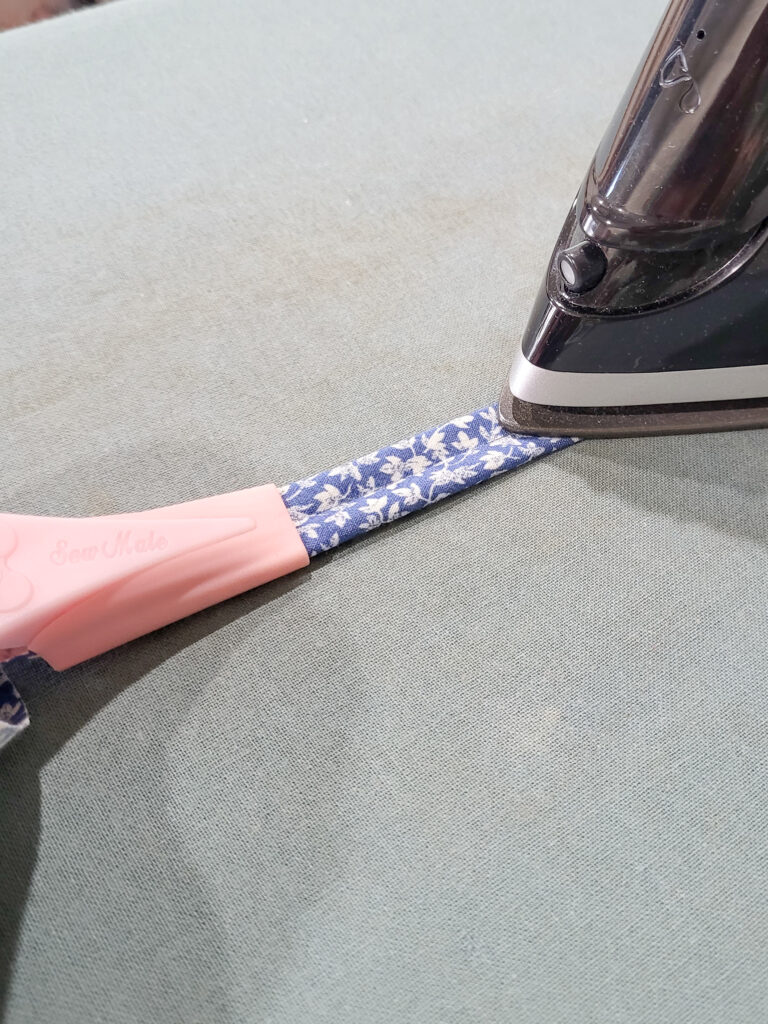
As you’re going, you may find the fabric shifting so the folded edges don’t exactly meet. When that happens, I push the bias tape maker back up to where the edges do meet, adjust the fabric a little, and then pull it back down until it looks right.
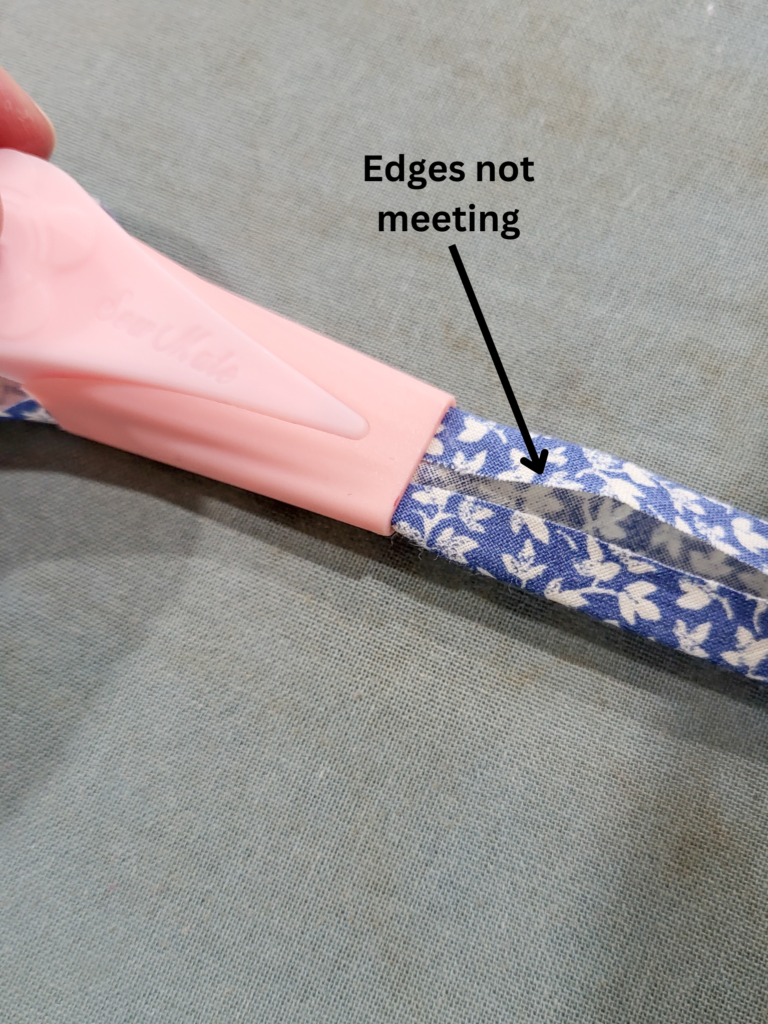
Once you’ve pulled all of your giant bias strip through the bias tape maker and ironed it, you’re almost done! To finish, I cut off the the diagonal edges on both ends so I have nice straight edges for when I start a project. If you’re making single fold bias tape, you are now done!
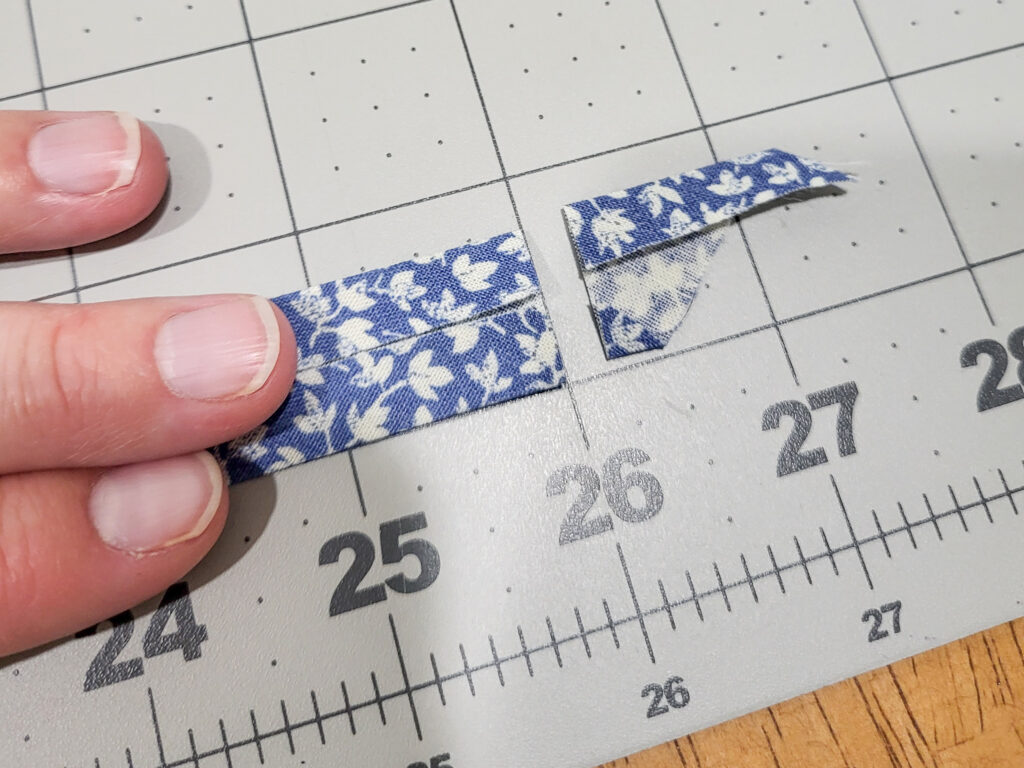
If you’re making double fold bias tape, you have one final step. Fold your tape in half with the folded edges staying on the inside. Iron as you fold, being careful not to burn your fingers as you go. Once you’ve completed that, you’re all done!
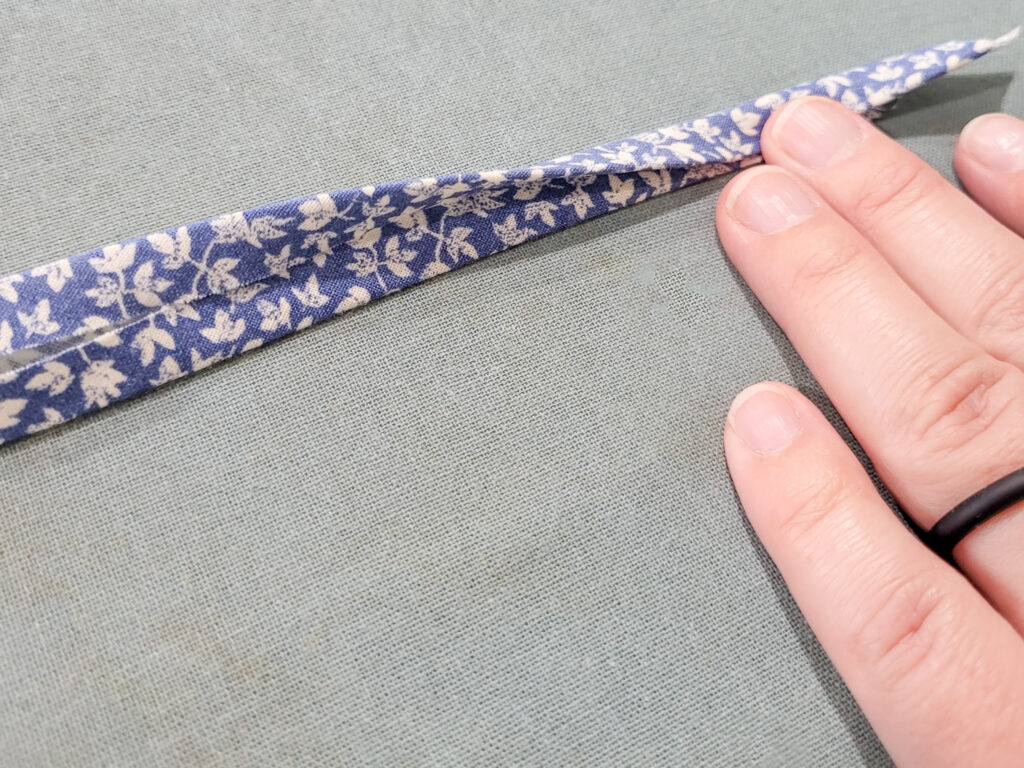
I recommend taking a moment to admire your handiwork. I find making bias tape to be a very rewarding project. The dainty print I used for this tutorial makes it difficult to find my seam line, and I love it!
Storing Your Bias Tape
When I finish up a package of store-bought bias tape, I often keep the cardboard piece the tape came wrapped around so I can use it to store my homemade stuff. You can also cut your own small pieces of cardboard, or find whatever works for you. One time when I couldn’t find anything else, I even wrapped it around an old CD case. As you wrap, make sure not to pull it too tightly so you don’t stretch it.
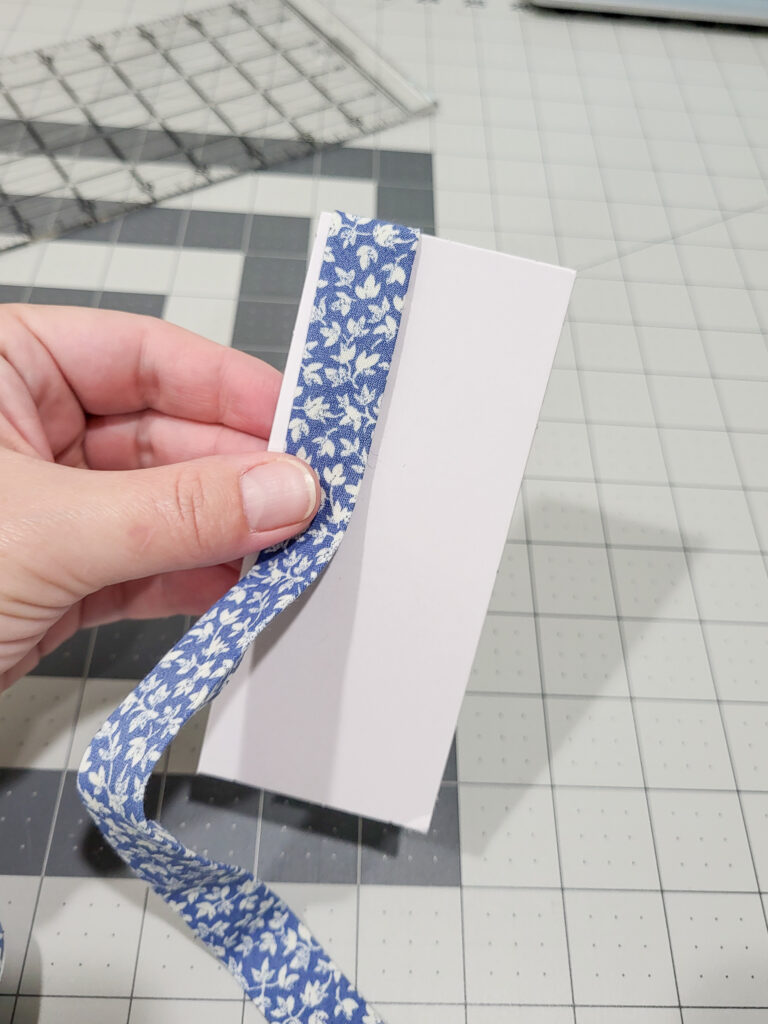
Alright - now you know how to make bias tape. I have my final product ready to go! Isn’t it beautiful?!
Things to Consider When Purchasing Bias Tape
OK. Now we've taught you how to make bias tape...but what if you'd rather just buy it and not go through the trouble. When purchasing bias tape, there are a few important factors to consider. First and foremost, you'll want to think about the material of the bias tape. It's important to choose a fabric that is durable and will hold up well over time. Additionally, consider the width and color of the bias tape. The width should suit your project, whether you're using it for binding edges or adding decorative elements. The color should complement your fabric or add a contrasting pop of color, depending on the desired effect. Lastly, pay attention to the quality of the bias tape. Look for well-made tape with even stitching and clean edges. By considering these factors, you can ensure that you're selecting the right bias tape for your sewing needs.
To sum it up, making bias tape is a simple and rewarding process that can add a professional touch to your sewing projects. Whether you're using it for binding edges, creating decorative accents, or adding a pop of color, bias tape is a versatile tool that every sewist should have in their toolkit. By following the step-by-step instructions outlined in this blog, you'll be able to make your own bias tape easily and efficiently. So why wait? Grab your favorite fabric and start creating beautiful and customized bias tape for all your sewing projects today!
Thanks again for joining us today. Before you leave, make sure to join our Peek-a-Boo Pattern Shop Facebook Group and sign-up for our Newsletter to keep up to speed on all of our new sewing tutorials and patterns.
